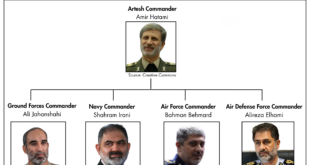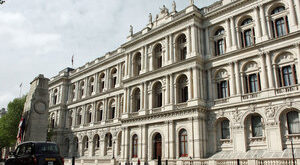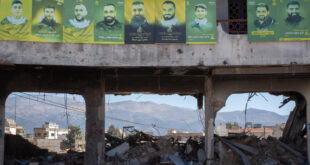In Iraq, after four years and three months of war, the echoes have begun to echo themselves.American troops are taking Baghdad’s streets back from insurgents. The prime minister has a plan for national reconciliation. To the south, in the “triangle of death,” two US soldiers are missing, captives in enemy hands.
Those were the headlines a year ago. Now they are being heard again in the newscasts of today, like some grim rewinding of a movie tragedy, of a story that never ends.
At the White House last June, back from a secretive trip to Baghdad, an upbeat US President George W. Bush told reporters assembled in the Rose Garden, “I sense something different happening in Iraq.” It is June again and those roses are once more in bloom.
But in Baghdad the scene looks only bleaker.
To a visitor returning after a year, the something different is the spread of concrete blast barriers across ever more of the city, the accumulation of still more rubble, the sectarian “cleansing” of neighbourhoods, the ruin of still more lives — of friends whose loved ones have fled, been kidnapped, been killed. And for those left behind, life is worse.
Old Baghdad’s constants remain: The sun, boiling orange, still slips below the western desert each evening, the river Tigris snakes, shallow and sluggish, through the city’s heart, the muezzins’ call to prayer still blares from countless mosques.
The constants of war also remain: The thud of sunrise explosions, somewhere, the zigzagging of convoys down the dangerous roads, the roar of Black Hawk helicopters skimming the tops of Baghdad’s minarets.
But the war also has taken new and different turns in the past year.
Insurgent bombers have targeted the bridges over the Tigris and over Baghdad’s critical highways. More than ever they are hitting the fortress-like Green Zone, home of the US embassy and Iraqi government, they have hammered the enclave with rockets and mortar fire more than 80 times since March, reportedly killing at least 26 people, UN figures show. On Tuesday, another mortar barrage hit the area.
The US forces in the latest “take back the streets” campaign are suffering more as well — 126 killed in Iraq overall this May, compared with 69 in May 2006.
Young soldiers’ attitudes are suffering, too, after repeat tours in Iraq. Almost half in a Pentagon survey released last month said their unit’s morale is low or very low.
Morale took a fresh blow when the army announced that 12-month tours would be extended to 15.
For Iraq’s army and police, the losses were even heavier.
And after easing earlier this year, the toll on civilians appears to be rising again in the unending cycle of sectarian killings by Sunni Muslim bombers and Shiite Muslim death squads. Last month was one of the bloodiest on record — by Associated Press count, at least 2,155 civilians and Iraqi security forces were killed.
This war has survived countless “turning points,” including last June’s killing of Abu Mussab Zarqawi, leader of Qaeda in Iraq, a US success some in Washington touted as a prelude to a “sea change” in US fortunes.
It was not. Now US hopes rest on “Imposing the Law,” the four-month-old security crackdown, a “surge” of US reinforcements billed as a promising change of strategy.
But this, too, is another echo — of “Together Forward,” launched in June last year, and “Lightning” of a year before that.
This 2007 operation already shows the weakness that undercut the others, lackluster support from an Iraqi army plagued with desertions and reluctant troops.
“Units that deployed came into Baghdad at only about 60 to 65 per cent of their authorised strength,” Lt. Gen. Martin Dempsey, outgoing chief US trainer for Iraqi forces, told an interviewer.
The US command points to progress in the western province of Anbar, where Sunni tribal chiefs have turned against Qaeda. But some of Anbar’s long-running violence seems simply to have moved to Diyala, a province north of Baghdad. On Tuesday, more than 10,000 US soldiers poured into Diyala’s capital, Baqouba, as part of major offensives against insurgents outside of Baghdad.
Sunni fighters remain defiant, meanwhile, in such strongholds as the “triangle of death” towns south of Baghdad, where they captured and killed two US soldiers in June last year, and seized two others, still missing, this May.
In Baghdad, death squads the past year have rearranged the sectarian checkerboard of neighbourhoods. The mixed west Baghdad districts of Hurriyah and Jihad have turned solidly Shiite, and Sunnis have driven Shiites from the southern district of Dora.
More and more, this centuries-old city is a maze of debris-blocked streets, abandoned houses and long gray walls of three-metre-high concrete barriers, erected by the Americans to guard against car bombings.
“In two months over 3,200 of these temporary protective barriers were put into Rusafa” — the part of Baghdad east of the Tigris River — said command spokesman Maj. Gen. William Caldwell last month.
Along with the everyday threats of death, Baghdadis have had to grapple, even more than they did a year ago, with the slow collapse of everyday life.
Electricity, available a few hours a day, grows scarcer.
Four years after the US vowed to restore power, the supply in early June was 8 per cent below the 2006 level.
Oil production, vital to Iraq’s economy, remains crippled — at levels even lower than last June’s production. The queues at gasoline stations sap hours of people’s days.
Many Iraqis could not cope. An estimated 650,000 — more than 2 per cent of the prewar population of about 27 million — have left the country since 2005, adding to more than one million already existing refugees. Some 2 million more have been driven from their homes but remain within Iraq, the UN refugee agency says.
Taking over in May 2006, Prime Minister Nouri Maliki pledged to push legislation to unify Iraq’s Shiite, Sunni and Kurdish factions. “We’ve got a prime minister who is very much hands-on,” said the US ambassador at the time, Zalmay Khalilzad.
Maliki’s efforts have foundered, however, and a new ambassador, Ryan Crocker, takes a less positive view.
“Whether it is ultimately within his power to bring Iraq to a successful state, I mean, again, I can’t tell you that it is,” Crocker said last month.
Amid more of the same, Iraqis wait.
Behind heavy security earlier this month, hundreds of Shiite and Sunni scholars gathered to promote Muslim and Iraqi unity, but in the end could offer little but the echo of a question from last year and years before.
“How long,” one asked, “will Iraqi blood be shed?”
 Eurasia Press & News
Eurasia Press & News


